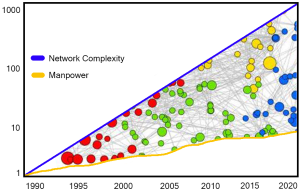Driving Blindfolded
I recently wrote about the necessity of getting the right data for security analytics. But I’m continuously reminded how typical organizations lack an even roughly complete understanding of their network, or even a map of it. I can understand why this happens – entropy is just as inevitable for organizations as it is in Physics. Records don’t just keep themselves – networks change, and ideally it’s all planned and well controlled, but in practice, emergencies happen, corners get rounded off, triage goes on, and perfect record keeping is lost. I know organizations who aim to have very strong processes, control, and accountability, and while I commend them for it, I find that if I look at their data, I still find enough gaps and unknowns to be a worry. Sure, the mature organizations do better – they don’t tend to have records in the moral equivalent of a shoe-box under the bed (but I see enough of those). But the records still don’t add up.

Of course, I’m preaching to the choir – anyone reading this blog probably already understands that this is important. I sometimes wonder if the real challenges are political, not technical or intellectual. When a security team can’t get the blueprints to the network, what exactly is going on? Is it overload? Is it lack of people to go hunt down what’s missing? Or is it the classic challenge of “nagging for a living”? Many security teams I meet don’t have direct access to the network assets that are critical to defensive posture. This means they have to ask, or beg, or cajole the NetOps team into providing data. The strength of that team-to-team relationship seems to be a really important issue. I’ve seen organizations vary hugely in speed and success with data analytics, depending on whether someone in Team Security has a buddy in Team Networking or not. Perhaps the worst cases I’ve seen involve outsourced IT and networking – then it can get to levels nothing short of passive-aggressive.
Got war stories? Advice? Rotten fruit? Comments welcome …

 At first, I didn’t want to talk about data gaps – that sounded like a challenge to good analytics. I was half right. Eventually, enough CISO’s got it through my skull that uncovering data gaps may be pointing to reasons why analytics will be held back, but it’s also major value, in and of itself. I was being dense – if we try to analyze security data, and we find it’s got holes in it, well, this means the security team didn’t know what was going on to start with! Turning up these gaps is one of those inconvenient truths. These days we’ve gotten pretty good at it.
At first, I didn’t want to talk about data gaps – that sounded like a challenge to good analytics. I was half right. Eventually, enough CISO’s got it through my skull that uncovering data gaps may be pointing to reasons why analytics will be held back, but it’s also major value, in and of itself. I was being dense – if we try to analyze security data, and we find it’s got holes in it, well, this means the security team didn’t know what was going on to start with! Turning up these gaps is one of those inconvenient truths. These days we’ve gotten pretty good at it.